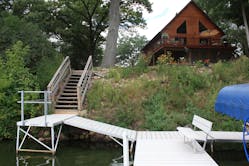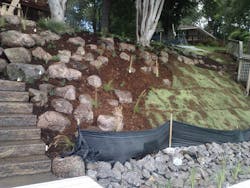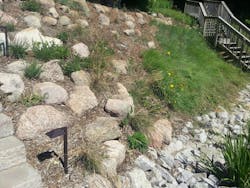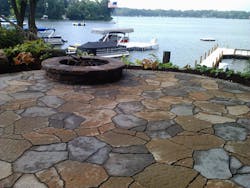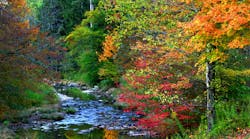Any landscape designer will tell you steep slopes can present some interesting challenges. Robert Livingston of Creative Edge Landscapes was contracted for a shoreline restoration and landscape design project along Lake Wisconsin in Merrimac, Sauk County, WI. The slope? Plunging 70-degrees to the shoreline. Not only that, but the site was also located at the end of the Lake Wisconsin watershed, which meant the site was susceptible to erosion issues. His goal was to create a natural patio/firepit area surrounded by plantings with a more permanent way to access the water while maintaining drainage patterns and securing the site from erosion. All of this was done with a three-person crew within three weeks.
The Lake Wisconsin watershed region is located mostly in Sauk and Columbia counties with the southernmost tip extending into Dane County in south-central Wisconsin. It consists of three municipalities—Poynette, Lodi, and Merrimac. It is a beautiful area that is well known for its sport fishery, extensive recreation, and scenic winding roads. The population growth in the area is high, as it is located just north of Madison. Lake Wisconsin is a major feature and covers 6.5% of the watershed’s area (WDNR, Lake Wisconsin).
The soil was comprised of a brown sandy loam with many intermittent rocks. Sandy loam soil is normally made up of sand along with varying amounts of silt and clay. Loamy soil is ideal for most garden plants, at least in a flat area, because it holds plenty of moisture but also drains well so sufficient amounts of air can reach the roots (Lerner, 2017). However, the steep slope and presence of rocks made the hillside unstable, with the added complication of drying out quickly.
“I knew that the slope would present several challenges. Every time I took a step the soil would move under my feet making it extremely difficult to walk up and down the hill. I felt like I was constantly going to fall. I needed a plan that would not only address erosion but also provide a sturdy base for plantings to become established,” says Livingston. “I wanted to create an aesthetic that suited the natural beauty of the site’s surroundings. The hardest part would be striking a balance between sustainability and practicality.”
Effective erosion control involves minimizing the duration of soil exposure to erosive conditions. Using multiple best management practices, protection can occur on many levels. Livingston proposed two options to the client, along with the pros, cons, and cost of each. The options consisted of using a product called a pre-vegetated blanket instead of traditional native seeding options or using turf sod. Whichever method was used to restore vegetation to the site, boulder cropping, retaining walls, mulch, and supplemental shore protection would be required to provide enough support for the plants to become established.
Pre-vegetated blankets use customized native seed mixes, providing flexibility for its use on any site. Native plants offer the most sustainable habitat for a given site as they have formed symbiotic relationships with native wildlife over thousands of years. Native plants thrive in the soils, moisture, and weather of their native region (NWF, Native Plants). This generally means they need less maintenance as they require less watering and use of pesticides.
“Herbaceous native plants, whether by themselves or within pre-vegetated blankets, improve soil stabilization because they have extensive root systems that can grow up to 16 feet in depth depending on the species,” says Livingston. “They also have larger root mass when compared to trees and shrubs or even their ornamental counterparts. This gives them the advantage of improving the soil conditions they are growing in, which makes them ideal for planting tough sites and increasing infiltration rates in areas prone to holding water or overly compacted. Letting nature do the work is the most sustainable thing I can do as a landscaper.”
Even with the staircase and boulders creating an easier way to get up and down the 70-degree slope, installation of the pre-vegetated blanket would pose an even greater challenge as the 4-foot, 1-inch by 7-foot, 11-inch sheets had to be carried across the slope to their final destination, overlapping to prevent scour and avoiding damaging blanket that had already been set. “It is definitely a balancing act on that steep of a slope with nothing to hang on to,” says Livingston, who adds jokingly, “I almost felt like I was in the circus.”
A total of 610 square feet of pre-vegetated blanket was installed on the slope. “GreenLine Synergy’s pre-vegetated blanket allowed us to continuously cover this steep slope with native plants to not only help with erosion and stabilization but also to provide a simplistic look with a pop of color in a natural area that had previously been overrun with messy looking invasive plants. Pre-vegetated blanket quickly stabilizes the steep slope because its basal root systems are already actively growing and take root quickly into the soil much like turf sod. Nature, in that way, is pretty amazing,” adds Livingston. The seed mix used for the pre-vegetated blanket consisted of 50% black-eyed Susan, 25% little bluestem, and 25% prairie dropseed.
The results were stunning. “Not only were we able to stabilize the slope, but we also made it visually appealing. Just as the client can enjoy a much more balanced, natural look while looking out over the lake, boaters on the lake can enjoy it as well. Native plants attract local wildlife adding another level of interest to the site. An added bonus!” says Livingston. However, Mother Nature would offer the true test.
Not even a week after the project was complete, there were multiple, substantial rain events averaging 2 inches or more every few days for the next month. Runoff pummeled the stairs, scouring out the sides of the step units and boulders as the ornamental style planting had not been given enough time to form a root matrix; however, only minimal repair work needed to be done to restore the project.
“I had a gut feeling Mother Nature walloped the area and I was concerned about the site. On my drive to the project site, I was bracing myself for the worst possible scenario. I was almost pleasantly surprised that there was minimal damage, considering the sheer amount of rain we had received and only a small amount of over-seeding had to be done,” says Livingston. “The basal root structures in the pre-vegetated blanket had already taken hold on the slope, so that saved us in the end. If the client would have gone with the seeding or sod option, the result would have been catastrophic.”
Looking back on the project Livingston says, “If I had to do it over, I’m not sure I would change anything. Well, except maybe the amount of rain we got. The pre-vegetated blanket already has an established root system when installed, allowing it to take hold quickly. Letting nature do what it’s intended to do is the best option possible. You learn quickly in this business that Mother Nature always has the upper hand. You just have to learn how to work with her and not against her.”
References
Lerner, Rosie. “What Is Loam?” Indiana Yard and Garden – Purdue Consumer Horticulture. Purdue University, March 1, 2017. www.purdue.edu/hla/sites/yardandgarden/what-is-loam/.
National Wildlife Federation. “Garden for Wildlife: Native Plants.” www.nwf.org/Garden-for-wildlife/about/native-plants.
Wisconsin Department of Natural Resources (WDNR). Lake Wisconsin Watershed (LW19) [PDF File]. Retrieved from www.dnr.wi.gov/water/basin/lowerwis/watersheds/lw19.pdf.
Wisconsin Department of Natural Resources (WDNR). Wisconsin Construction Site Erosion Control Field Guide [PDF File]. Retrieved from www.dnr.state.wi.us/topic/stormWater/documents/WIconstECfieldGuide.pdf.

